Flathead Catfish, Pylodictis olivaris
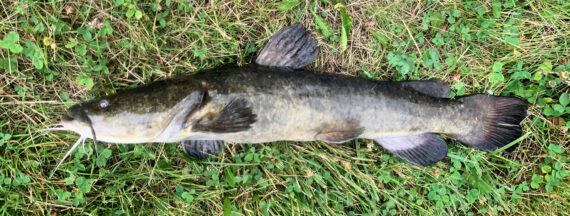 Flathead Catfish, Pylodictis olivaris. Fish caught in the Des Moines River, Des Moines, Iowa, July 2020. Length: 41 cm (16 inches). Catch, photograph and identification courtesy of Luke Ovgard, Klamath Falls, Oregon.
Flathead Catfish, Pylodictis olivaris. Fish caught in the Des Moines River, Des Moines, Iowa, July 2020. Length: 41 cm (16 inches). Catch, photograph and identification courtesy of Luke Ovgard, Klamath Falls, Oregon.
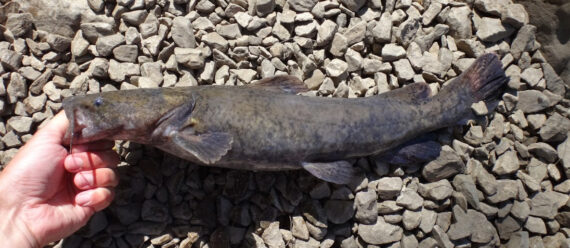
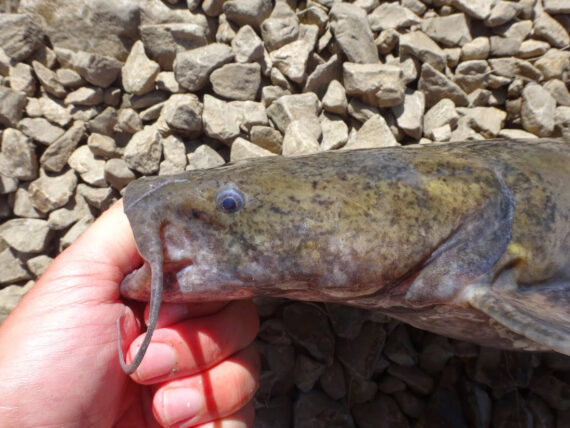
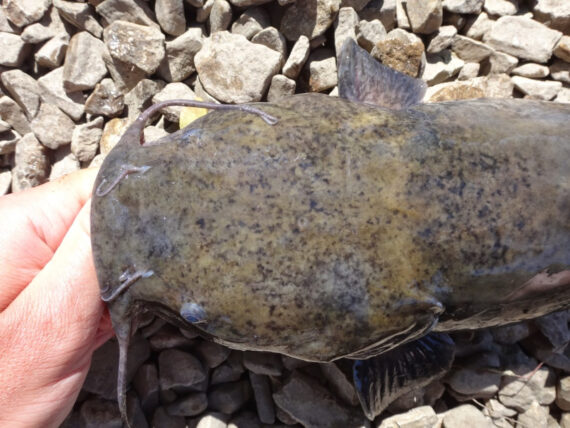 Flathead Catfish, Pylodictis olivaris. Fish caught from the Kaskaskia River, Carlyle, Illinois, April 2015. Length: 45 cm (18 inches). Catch, photograph, and identification courtesy of Ben Cantrell, San Diego, California.
Flathead Catfish, Pylodictis olivaris. Fish caught from the Kaskaskia River, Carlyle, Illinois, April 2015. Length: 45 cm (18 inches). Catch, photograph, and identification courtesy of Ben Cantrell, San Diego, California.
 Flathead Catfish, Pylodictis olivaris. Fish caught from the Kaskaskia River, Carlyle, Illinois, April 2015. Length: 88 cm (2 feet 11 inches).Catch, photograph, and identification courtesy of Josh Leisen (joshadventures.com), Gaylord, Michigan.
Flathead Catfish, Pylodictis olivaris. Fish caught from the Kaskaskia River, Carlyle, Illinois, April 2015. Length: 88 cm (2 feet 11 inches).Catch, photograph, and identification courtesy of Josh Leisen (joshadventures.com), Gaylord, Michigan.
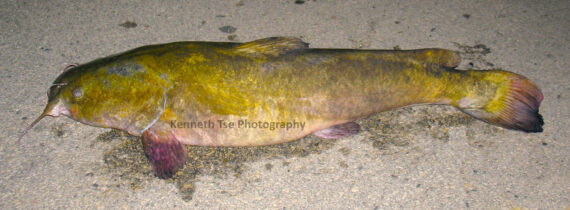 Flathead Catfish, Pylodictis olivaris. Fish caught from the Schuylkill River, Philadelphia, Pennsylvania, August 2014. Length: 88 cm (2 feet 11 inches). Weight: 7.7 kg (17 lbs 0 oz). Catch, photograph, and identification courtesy of Kenneth Tse, Toronto, Ontario, Canada.
Flathead Catfish, Pylodictis olivaris. Fish caught from the Schuylkill River, Philadelphia, Pennsylvania, August 2014. Length: 88 cm (2 feet 11 inches). Weight: 7.7 kg (17 lbs 0 oz). Catch, photograph, and identification courtesy of Kenneth Tse, Toronto, Ontario, Canada.
The Flathead Catfish, Pylodictis olivaris, is a member of the North American Catfish or Ictaluridae Family, that is also known as the Mud Catfish and in Mexico as bagre piltontle. Globally, there are fifty-one species in the Ictaluridae Family, which have been placed in seven genera and include blue catfish, bullheads, channel catfish, and madtoms. The Pylodictis Genus has one global member of this species which is found in the freshwater systems of North America.
The Flathead Catfish has an elongated thick body that is compressed posteriorly. They are a yellow to purple-brown color dorsally and transition to pale white to yellow ventrally. In smaller fish, the upper lobe of the caudal fin is white tipped. Their head is wide and flat with small eyes, a wide oval shaped mouth that is equipped with small teeth in villiform bands, with a protruding lower jaw with 4 pairs of black sensory barbells, 4 on the chin, 2 on the snout, and 1 on each corner of the mouth. Their anal fin has 14 to 17 rays with a short, rounded profile; their caudal fin is slightly forked; they have a single dorsal fin which has 6 or 7 rays followed by an adipose fin; their pectoral fins have 8 to 11 rays; and, their pelvic fins have 9 rays. They have 8 to 10 gill rakers. They have smooth skin and no scales. The females and the males are similar in physical appearance.
The Flathead Catfish are generally found in slow moving waters of rivers, lakes and reservoirs in and around vegetative cover at depths up to 6 m (14 feet). The juveniles are found in shallower water than the adults. The larger fish stay in deeper waters during the daylight hours and move to shallower waters to feed at night. They have the ability to tolerate low levels of saline but cannot survive in sea water. They are the second largest catfish reaching a maximum of 1.75 m (5 feet 9 inches) in length and 63 kg (140 lbs) in weight. The Flathead Catfish is considered to be the apex predator in most environments that ambush live prey. They are carnivores that consume a wide variety of live small fishes. They also consume crayfish, insects and larvae and their own. Juveniles primarily consume insect larvae. They become inactive in water temperatures below 10oC (50oF). The major predators of Flathead Catfish are larger Flathead Catfish and humans. Their larvae and juveniles are preyed upon by other fish and wading birds. They rely on cryptic coloration to avoid predation. Reproduction occurs in annual cycles and is oviparous and monogamous and occurs in waters between 21oC (70oF) and 27oC (81oF) in temperature. Nests are normally built by the males near submerged logs and debris at depths up to 5 m (16 feet). Each female will deposit up to 100,000 eggs in a nest which are then fertilized by the males. The males vigorously defend the nests which includes excluding the females to avoid cannibalization. The eggs are adhesive, attach to the substrate, and will hatch in 6 to 10 days and will remain in the nest area for another two weeks until they disperse. They have life spans of twenty-eight years.
The Flathead Catfish is not easily confused with any other freshwater catfish due to their wide and flat heads and the wide tip on the upper lobe of the caudal fin.
The Flathead Catfish is a native to the Mississippi and Gulf drainages in the United States and within the fresh water rivers of Northern Mexico. They have been widely introduced throughout the United States. They have the ability to rapidly colonize river systems and these introductions are probably the most biologically harmful of all fish introductions in North America as they significantly reduce or eradicate the abundance and diversity of native prey species in several areas.
From a conservation perspective the Flathead Catfish is currently considered to be of Least Concern with stable, widely distributed populations. In many areas they are considered to be highly invasive pests. The Flathead Catfish is a favorite target species by recreational anglers due to their size and food value. They are fished by a variety of methods including the art of noodling (bare hands fishing). Efforts to raise them by aquaculture has failed due to cannibalism. They are of limited interest to the aquarium trade as they will consume their smaller tank mates and they can get very large very quickly; they can be found in the larger public aquariums.